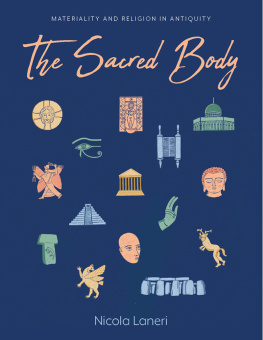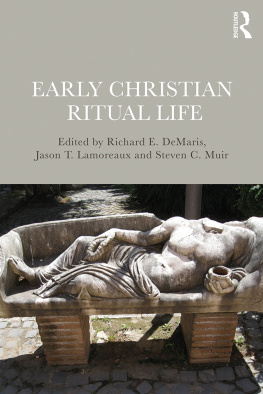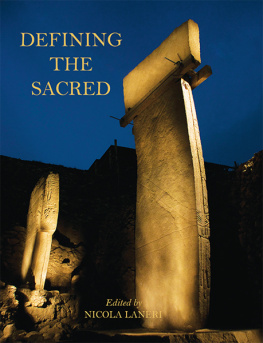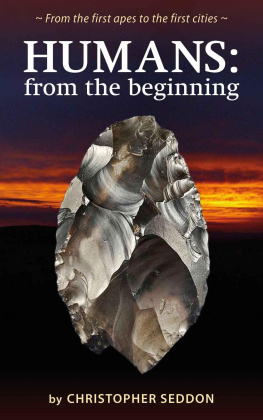Pagebreaks of the print version

The Sacred Body
Materializing the divine through human remains in antiquity
edited by
Nicola Laneri
Material Religion in Antiquity (MaReA) Volume 1
Published in the United Kingdom in 2021 by
OXBOW BOOKS
The Old Music Hall, 106108 Cowley Road, Oxford OX4 1JE
and in the United States by
OXBOW BOOKS
1950 Lawrence Road, Havertown, PA 19083
Oxbow Books and the individual contributors 2021
Hardback Edition: ISBN 978-1-78925-518-8
Digital Edition: ISBN 978-1-78925-519-5 (ePub)
Kindle Edition: ISBN 978-1-78925-521-8 (mobi)
A CIP record for this book is available from the British Library
Library of Congress Control Number: 2021932102
All rights reserved. No part of this book may be reproduced or transmitted in any form or by any means, electronic or mechanical including photocopying, recording or by any information storage and retrieval system, without permission from the publisher in writing.
For a complete list of Oxbow titles, please contact:
| UNITED KINGDOM | UNITED STATES OF AMERICA |
| Oxbow Books | Oxbow Books |
| Telephone (01865) 241249 | Telephone (610) 853-9131, Fax (610) 853-9146 |
| Email: | Email: |
| www.oxbowbooks.com | www.casemateacademic.com/oxbow |
Oxbow Books is part of the Casemate Group
Front cover: Illustrated by Karen Abend.
Contributors
V ALENTINA DA MICO
Husbio L Laboratory, Department of
Anthropology, Hacettepe University, 06800,
Ankara, Turkey
K ATHLYN C OONEY
University of California, Los Angeles (UCLA) 445
Charles E. Young Drive East 2418 Schoenberg,
Music Building, Los Angeles, California, 90095, USA
M ELISSA S. C RADIC
Herbert D. Katz Center for Advanced Judaic
Studies, University of Pennsylvania, 420 Walnut
St, Philadelphia, PA 19106, USA
Y ILMAZ S ELIM E RDAL
Husbio_L Laboratory, Department of
Anthropology, Hacettepe University, 06800,
Ankara, Turkey
N ICOLA L ANERI
University of Catania, Piazza Dante,
32 95124 Catania, Italy
and School of Religious Studies, CAMNES,
Via Del Giglio 15 50123 Florence, Italy
A RIANNA R OTONDO
University of Catania, Piazza Dante, 32 95124
Catania, Italy
L OUISE S TEEL
University of Wales Trinity Saint David 15
College Street, Lampeter, Ceredigion SA48 7ED, Wales
L IV N ILSSON S TUTZ
Department of Cultural Sciences, Linnaeus
University, S 391 82, Kalmar, Sweden
V ERA T IESLER
Universidad Autnoma de Yucatn, km. 1,
Carretera Mrida Tizimn Cholul, Mrida, C.P.
97305, Mrida, Yucatn, Mexico
E RIK V ELSQUEZ G ARCA
Instituto de Investigaciones Estticas,
Universidad Nacional Autnoma de Mxico,
Delegacin Coyoacn 04510, Mexico City, Mexico
Chapter 1
The Sacred Body: introduction
Nicola Laneri
The physical body can have universal meaning only as a system which responds to the social system, expressing it as system. What it symbolizes naturally is the relation of parts of an organism to the whole. Natural symbols can express the relation of an individual to his society at that general systemic level. The two bodies are the self and society: sometimes they are so near as to be almost merged: sometimes they are far apart. The tension between them allows the elaboration of meanings.
(Douglas 1996, 87)
The human body serves as a symbolic bridge between communities of the living and the divine. This is clearly evident in mythological stories that recount the creation of humans by deities within ancient and contemporaneous societies across a very broad geographical environment.
In certain circumstances, parts of selected humans can become an ideal proxy for connecting with the supernatural, as demonstrated by the cult of human skulls in Near Eastern Neolithic communities, as well as the cult of relics of Christian saints from the early Christian era.
To go deeper into this topic, this volume aims to undertake a cross-cultural investigation of the role played by both humans and human remains in creating forms of relationality with the divine in antiquity. Such an approach will highlight how the human body can be envisioned as part of a broader materialization of religious beliefs that is based on connecting different realms of materiality in the perception of the supernatural by communities of the living.
The human body as a proxy to the cosmos
It is through the body that animals experience the world and nourish their way of being in it. Mating, fighting, smelling, eating and observing other animals behaviors are central for an active learning process, all of which are experienced through. The body is pivotal for being in the world and relating to nature and other members of the community. This is even more evident when dealing with the human body, considering that we are social animals and it is through the body that we experience the social world. In fact, this is explained by the process of embodiment, because, as pointed out by Merleau-Ponty (1962, 186), it is through my body that I understand other people; just as it is through my body that I perceive things.
However, the beginning of an anthropology of the body in the 1970s mostly interpreted the social body as a constraint to the physical body; for example, Mary Douglas (1996, 69) stated that the physical experience of the body, always modified by the social categories through which it is known, sustains a particular view of society. Such a duality, reminiscent of the Marcel Mausss techniques du corps (1936), is based on a socio-centric perspective that envisions the human body as determined by the sociological environment in which it acts. It should instead be revised using a perspective through which the body (and the mind) is viewed in relationship with the natural, cultural and social environment in ways in which the physical organism constrains and inspires patterns of social interaction and the invention of culture (Blacking 1977, vvi). Following this perspective, the body becomes an active and complex agent that is the result of our embodied materialities and socialities (Mascia-Lees 2011, 2) constructed through forms of relationality based on lived experiences (Crossland 2011).
Thus, being in the world and connecting with others represents a process of embodiment that leaves profound traces in our cognitive mapping as well as in the way we define ourselves in relationship to the world around us that has been learnt throughout our life. Thus, the human body assumes the role of the real axis mundi between the natural world, the social construct, and the supernatural. For ancient people, the centrality of the human body as a projection onto elements of nature (Connerton 2011, 142) was pivotal in the construction of the world surrounding their communities as well as in defining their relationship with the cosmos. This is, for example, the vision that the ancient Roman author Vitruvius (Rowland and Noble Howe 2001) had in relating the human body with religious architecture, as discussed in his famous first book, On Symmetry: in temples and in the human body . According to him, the perfect symmetry that is visible in the human body should also be used as a model for the construction of religious architecture. This extraordinary statement captures the importance of the human body in constructing the architecture surrounding us that is then, centuries later, illustrated by Leonardo Da Vinci in the depiction of the Vitruvian Man (ca. 1490), which is still considered to be a masterpiece of humankind (Borgo 2019). In the drawing, da Vinci has created a visual representation of the notion of sacred geometry, whereby the human body is viewed as a perfectly symmetric creation of God. Thus, returning to the idea of Vitruvius, if God made humans with such an incredible eye for symmetry, humans should apply this same principle to the construction of the built environment (and especially sacred architecture).








